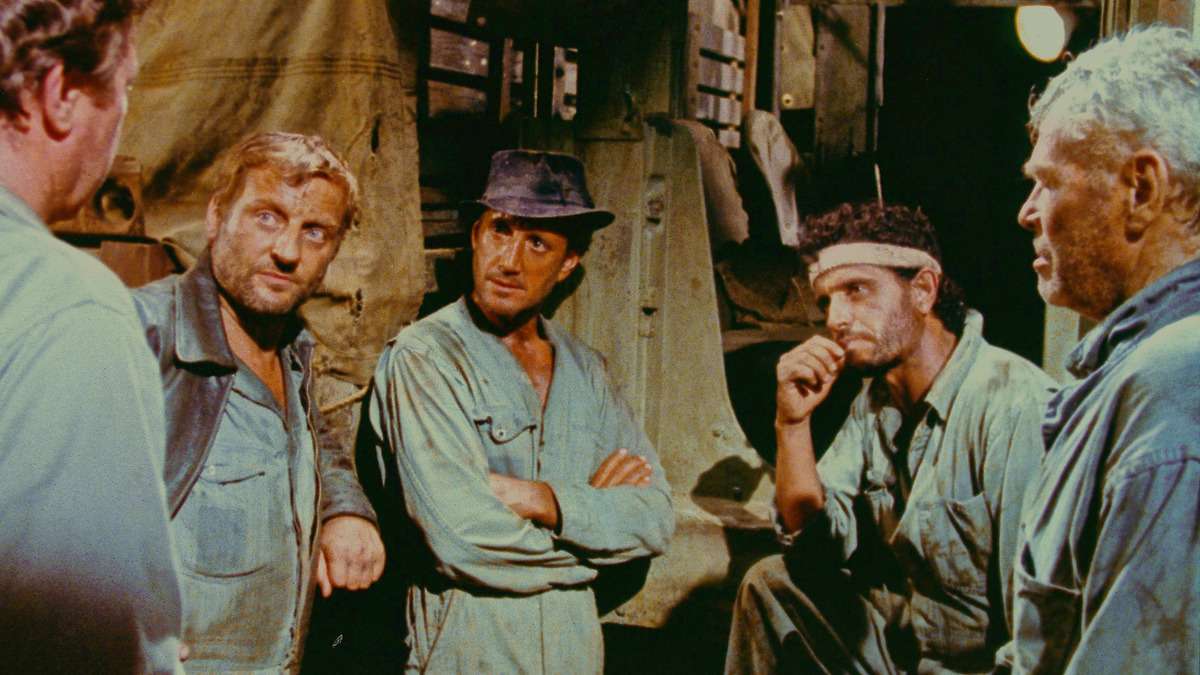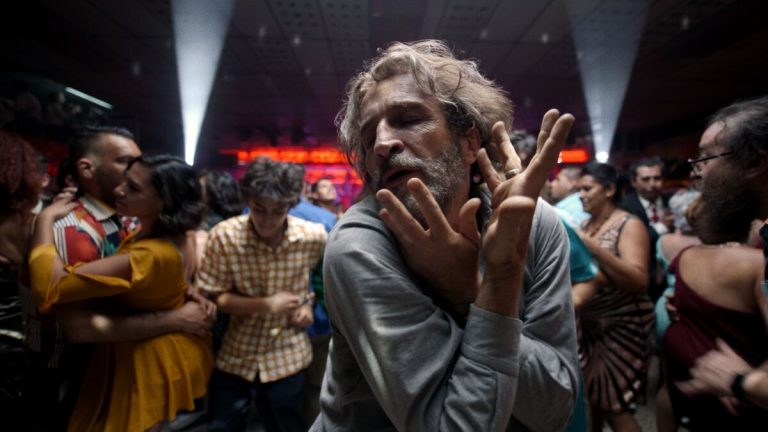After the success of “The French Connection” and “The Exorcist,” William Friedkin became one of the most in-demand filmmakers in Hollywood. Having the option to choose his own projects, he opted to adapt Georges Arnaud’s 1950 novel “The Wages of Fear.” This was the second adaptation of the novel after Henri-Georges Clouzot’s critical darling of the same name, released in 1953, which won both the Golden Bear and the Palme d’Or. While Friedkin admired Clouzot’s work and even dedicated his film “Sorcerer” to Clouzot, the tone and treatment of his film were completely different from the earlier adaptation. In this article, I will discuss the two films and explore how despite being based on the same source material they became two distinct cinematic works.
Clouzot’s film starts in a small town somewhere in Latin America, filled with impoverished foreigners. The most prominent among them are Mario, a Corsican playboy (Yves Montand), who spends his days slacking and flirting with a local girl named Linda; Luigi (Folco Lulli), an Italian bricklayer at the Southern Oil Company—the only place the locals can find work—who is also Mario’s roommate; Bimba (Peter van Eyck), a Dutchman who does odd jobs for the local saloon owner; and Jo (Charles Vanel), a mysterious Frenchman who has newly arrived in town, possibly in hiding. The four of them have their differences, but they agree to work together to transport highly unstable nitro-glycerine, which can explode with the slightest vibration, to a nearby oil field to extinguish a well fire in exchange for a hefty payment that could change their fortunes.
While the film is narratively solid with its heightened suspense, it is also a profound character study. Throughout the movie, the dynamics between the characters shift due to their circumstances. Mario and Luigi start as best friends, but their relationship sours as Mario begins spending more time with Jo. Meanwhile, Jo’s cowardly attempts to abandon Mario in a couple of instances during their journey create a contemptuous relationship. Yet, they must all work together to survive. Clouzot portrays these evolving relationships with humanity and pragmatically showcases the characters without sensationalism. They are who they are, making them more relatable.
In Friedkin’s gritty adaptation, “Sorcerer,” all of the main characters’ backstories are revealed in the first 25 minutes. First, there is Nilo, a Mexican hitman who is seen assassinating someone in Vera Cruz in the opening scene. Kassem, a young Palestinian terrorist, flees Jerusalem after orchestrating an attack and witnessing the subsequent crackdown, in which all his accomplices are either killed or arrested. Then, there is Victor Manzon, an investment banker from Paris accused of fraud. He is given 24 hours to provide collateral to have the charges dropped.
Desperate, he insists that his brother-in-law, Pascal, ask his father for the money. When Pascal’s father refuses, Pascal kills himself in his car. This frightens Victor, prompting him to flee the country. Finally, we meet Jack Scanlon, an Irish mobster who survives a car accident following a heist in a Catholic church. The Italian Mafia is now after him because the church is under their control, and the crew has injured a priest who turns out to be the brother of an Italian Mafia kingpin. In this predicament, Scanlon flees the country and relocates to Porvenir, a small Latin American village plagued by extreme poverty. Coincidentally, all the other characters end up in the same place.
Also Read: The 30 Greatest Cannes Palme d’Or Winners of All Time
Friedkin creates a stark contrast with “The Wages of Fear” by presenting these backstories in the first half-hour. Whereas The Wages of Fear never sentimentalizes its characters, Friedkin’s approach does exactly that. His characters seek redemption for their past deeds, a redefinition of the original work that ultimately misfires. While Clouzot sees his characters with humanity, Friedkin remains too dispassionate to find any in them. They are shallow and have little to offer individually. Instead, they serve as catalysts for highlighting their surroundings, which marks the key distinction between “The Wages of Fear” and “Sorcerer.” “The Wages of Fear” is a character study, whereas Sorcerer focuses more on its milieu than on its characters.
In The Wages of Fear, the milieu serves as a catalyst for the character study. The film’s central question is: How do the characters react in a dangerous situation like this? Thus, the setting acts as a narrative device that shapes the characters. However, in “Sorcerer,” Friedkin explores how the characters attempt to define the setting. To understand this, we must examine the setting more closely.
Both films are set in Latin America and contain commentary on economic colonialism. However, as an American film, “Sorcerer” is more explicit in this critique, and Friedkin’s portrayal of the exploitation by American capitalists is unnerving. His cinéma vérité style often leaves the characters to navigate the setting, emphasizing the extreme conditions of life and how foreigners exploit the locals. He epitomizes this with a disturbing sequence in which the dead bodies of oil well fire victims are brought to the village, illustrating how the weak always pay the price for greed. Additionally, the film echoes American interventionist foreign policy, reflecting the recently ended Vietnam War at the time of its release.
Friedkin’s primary concern is exploitation, which extends beyond the environment and local people to a hierarchy of who can exploit whom. In my opinion, this hierarchy of power is perhaps the common ground between the two films. The oil company exploits both the environment and the locals, including the four main characters. In turn, these four characters exploit those they perceive as inferior. For example, in “The Wages of Fear,” Mario treats Linda, his devoted love interest, with disdain. However, while “The Wages of Fear” humanizes these exploitations, “Sorcerer” presents them in a grotesque and repulsive manner. Perhaps, as an American filmmaker, Friedkin was too preoccupied with the concept of exploitation, leading to a sense of guilt in his portrayal. As a result, he denies his characters the humanity Clouzot afforded them. In “Sorcerer,” they must be amoral and seek redemption, serving as a national conscience.
Both “The Wages of Fear” and “Sorcerer” stand out for their respective merits and flaws. While the former is an existential character study, the latter is more an exploration of exploitation induced by Western powers on economically weaker countries. Though Friedkin’s film delicately handles its subject matter, “Sorcerer” ultimately becomes a lesser film. It contains thrilling adventure sequences and magnificent set pieces, yet its episodic narrative prevents these elements from coalescing into a coherent whole. On the other hand, the prolonged suspense sequences in “The Wages of Fear” are seamlessly woven together by the screenplay, and the well-rounded characters elevate the film, making it a superior work. Either way, this is a good example of how the source material can be carved out to different perspectives coming from different cultural backgrounds.








